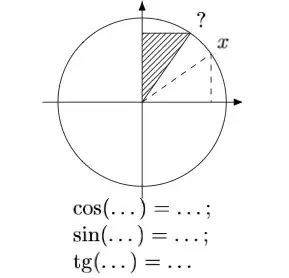The following identity is true for any given $x \in [-1,1]$: $$\arcsin(x) + \arccos(x) = \frac{\pi}{2}$$
But I don't know how to explain it.
I understand that the derivative of the equation is a truth clause, but why would the following be true, intuitively?
$$\int^{x}_{C1}\frac{1\cdot dx}{\sqrt{1-x^{2}}} + \int^{x}_{C2}\frac{-1 \cdot dx}{\sqrt{1-x^{2}}} =\\ \arcsin(x) - \arcsin(C1) + \arccos(x) - \arccos(C2) = 0 \\ \text{while } \arcsin(C1) + \arccos(C2) = \frac{\pi}{2}$$
I can't find the right words to explain why this is true?
Edit #1 (25 Jan, 20:10 UTC):
The following is a truth clause:
$$
\begin{array}{ll}
\frac{d}{dx}(\arcsin(x) + \arccos(x)) = \frac{d}{dx}\frac{\pi}{2} \\
\\
\frac{1}{\sqrt{1-x^{2}}} + \frac{-1}{\sqrt{1-x^{2}}} = 0
\end{array}
$$
By integrating the last equation, using the limits $k$ (a constant) and $x$ (variable), I get the following:
$$ \begin{array}{ll} \int^x_k\frac{1}{\sqrt{1-x^{2}}}dx + \int^x_k\frac{-1}{\sqrt{1-x^{2}}}dx = \int^x_k0 \\ \\ \arcsin(x) - \arcsin(k) + \arccos(x) - \arccos(k) = m \text{ (m is a constant)}\\ \\ \arcsin(x) + \arccos(x) = m + \arcsin(k) + \arccos(k) \\ \\ \text{Assuming that } A = m + \arcsin(k) + \arccos(k) = \frac{\pi}{2} \text{ ,for } x \in [-1,1] \end{array} $$ Using Calculus, why is that true for every $x \in [-1,1]$?
Edit #2:
A big mistake of mine was to think that $\int^x_k0 = m \text{ (m is const.)}$, but that isn't true for definite integrals.
Thus the equations from "Edit #1" should be as follows: $$ \begin{array}{ll} \int^x_k\frac{1}{\sqrt{1-x^{2}}}dx + \int^x_k\frac{-1}{\sqrt{1-x^{2}}}dx = \int^x_k0 \\ \\ \arcsin(x) - \arcsin(k) + \arccos(x) - \arccos(k) = 0\\ \\ \arcsin(x) + \arccos(x) = \arcsin(k) + \arccos(k) \\ \\ A = \arcsin(k) + \arccos(k) = \frac{\pi}{2} \text{ ,for } x \in [-1,1] \end{array} $$


